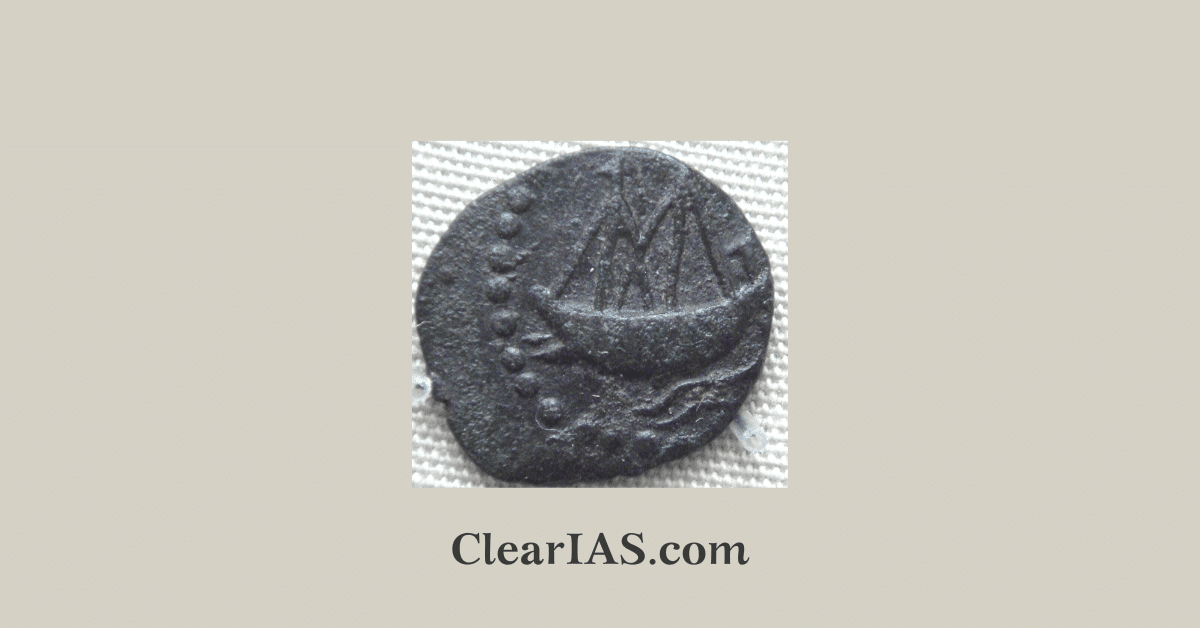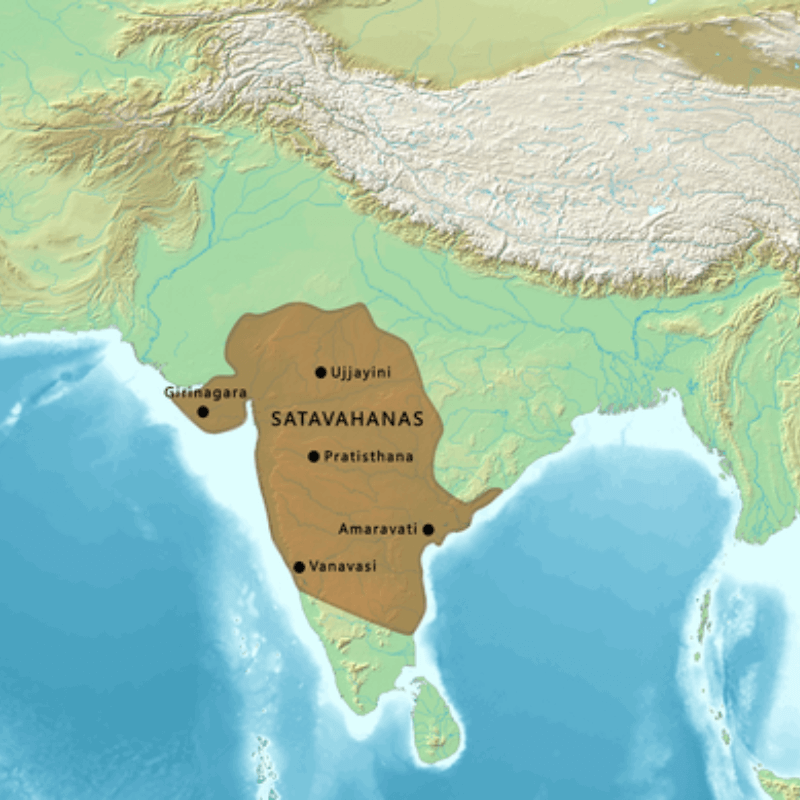
The Satavahana dynasty ruled the Deccan region after the decline of the Mauryan empire. In the post-Maurya era, the Satavahana rule brought peace to the Deccan region and resisted the assault of foreign invaders. Read here to learn more about the ancient kingdom.
The Satavahanas were an ancient Indian dynasty with its capital in the Deccan area. The Satavahanas are also known as the Andhras in the Puranas.
Most current academics think that the Satavahana dynasty began in the late second century BCE in the post-Maurya era, and lasted until the early third century CE.
The majority of the modern-day states of Andhra Pradesh, Telangana, and Maharashtra made up the Satavahana kingdom. They ruled over portions of modern-day Gujarat, Madhya Pradesh, and Karnataka at various points in time.
Satavahana dynasty: Origin and expansion

The Mauryan Empire, which had collapsed and fallen apart by the early half of the second century BCE, gave rise to the Satavahanas.
- The Satavahanas and Chedi monarchs of Odisha took over after the Mauryans, who had previously ruled over the Andhra kingdom and the whole Deccan.
- While the precise date of the establishment of Satavahana authority cannot be pinpointed, Puranic records indicate that Simuka, the first monarch, may have started to rule about 230 BCE.
- However, evidence points to Satavahana as the dynasty’s true founder, not Simuka, who was simply a direct descendant of him.
- Inscriptions claim that in the first century BCE, the Satavahanas decimated the Kanva armies to establish their presence in the Deccan.
Satakarni I conquered western Malwa, Anupa (Narmada valley), and Vidarbha, taking advantage of the turmoil caused by Greek invasions of northern India.
- He performed Vedic sacrifices including Ashvamedha and Rajasuya. Instead of the Buddhists, he patronized Brahmins and donated a substantial amount of wealth to them.
- The Hathigumpha inscription of the Kalinga king Kharavela mentions a king named “Satakani” or “Satakamini”, who some identify with Satakarni I.
Any empire’s history is frequently defined by its battles with other modern powers, and in the case of the Satavahanas, the Sakas of Seistan proved to be a persistent danger.
- Before the first century BCE, the East Iranian people known as the Sakas established a foothold in the Indus valley. They are also known as Indo-Scythians.
- Between 40-80 CE, the Saka’s dominance grew at the cost of the Satavahans, with Nahapana serving as their greatest conquistador.
Gautamiputra Satakarni is often credited with reviving the fortunes of the Satavahanas after acceding to the throne around 106 CE.
- He is described as the destroyer of the Sakas, Pahlavas, and Yavanas (Saka-yavana-pahlavanisudana).
- He decisively defeated the powerful Kshaharatha ruler Nahapala and recovered many territories that the Shakas had earlier wrested from the Satavahana
Rulers of the Satavahana dynasty
- Simuka: Simuka is considered the founder of the Satavahana dynasty. He established the dynasty and is believed to have laid the foundation for its expansion as mentioned in a Satavahana inscription at Naneghat.
- Kanha (70-60 BCE): Simuka was succeeded by his brother Kanha (also known as Krishna), who extended the kingdom up to Nashik in the west.
- Satakarni I (70-60 BCE): Satakarni I was one of the significant rulers of the dynasty. He is credited with expanding the empire’s boundaries and increasing its influence by conquering Kalinga.
- Satakarni II: He is said to have ruled for 56 years, during which he captured eastern Malwa from the Shungas. This allowed him access to the Buddhist site of Sanchi, in which he is credited with the building of the decorated gateways around the original Mauryan Empire and Sunga stupas.
- Hala (20-24 CE): Hāla was a notable ruler known for his patronage of literature and the arts. He is particularly known for the compilation of the anthology “Gaha Sattasai,” which contains poems in Prakrit.
- Sivasvati (1st century CE)
- Gautamiputra Satakarni (1st century CE): Gautamiputra Satakarni was one of the most famous Satavahana rulers. He is known for his military campaigns and successful efforts to consolidate and expand the empire’s territories.
- Vasishthiputra Pulumavi (130-159 CE): Pulumavi was the son of Gautamiputra Satakarni and continued his father’s expansionist policies in and around the river Krishna.
- Vashishtiputra Satakarni
- Shivaskanda Satakarni
- Yajna Sri Satakarni: He is another important ruler who maintained the dynasty’s territorial holdings and influence. After his reign, the empire gradually declined as the succeeding monarchs weren’t able to maintain their control over feudatories who in turn may have gained in strength.
Administration and Economy
The Satavahana rulers established a well-organized administrative system with a focus on local governance.
- Janapada denoted the largest territorial division of the empire.
- It was subdivided into rashtras for administrative efficacy with the head known as Rashtrika.
- If the Rashtra division was large, then its head came to be known as Maharathi.
- The next sub-division was ahara which corresponds to modern districts. They were ruled by officers called Amatyas. The aharas were divided into vishayas.
- The villages were the lowest unit of administrative division and their names mostly ended in grama or padraka.
- The village headman was called Gramani as mentioned in some gathas of the Gatha-saptasati.
The kingdom had three grades of feudatories:
- Rajas who struck coins in their names
- Mahabhojas and Maharathis were very influential families in the western Deccan. From the inscriptions of the Satavahana period, we find that the feudatories in Thane and Kolaba districts were known as Mahabhojas while those in the Poona district were designated as Maharathis.
- Mahasenapati was instituted late in the history of Satavahanas
The Satavahana kings did not bear high-sounding titles; rather they were simply called Rajan. Maharaja was rarely used.
The ruler appointed several ministers & executive officers to assist him in administration.
- The officers in the king’s ministry were called Raj-amatyas.
- Besides, other officers mentioned in the inscription were: Senapati(the Army Commander), Rajjuka (the Revenue Officer), Bhandagarika (the Treasurer), Paniyagharika (the Superintendent of Water Works), Karmantika (the Superintendent of Public Works) & Avesanika (the foreman).
Economy
They were known for their active trade and commerce, especially in the maritime trade routes that connected the Deccan to the western coast and other parts of the world.
- The income of the state under the Satavahanas was derived from land revenue and other cesses, taxes levied on commodities, excise duties, fines imposed on offenders, and other means. Some portion of income was also derived from State-owned lands.
- Inscriptions make no mention of the crops produced in the Satavahana age but some crops like rice, wheat, sugar, jawar, bajra, and cotton were mentioned in the Gathasaptasati.
The dynasty controlled key trade routes, contributing to their economic prosperity.
- Maritime trade was flourishing from the ports of Broach, Kalyan, and Sopara.
- Indian ship on lead coin of Vasisthiputra Sri Pulamavi was the testimony to the naval, seafaring, and trading capabilities of the Satavahanas during the 1st–2nd century CE.
- The Satavahanas carried on a flourishing trade with foreign countries like Egypt and Greece.
- The exports included sesame oil, sugar, animal skins, cotton fabrics, silk, muslin, jewels, ornaments, etc. The goods imported were Roman wine, copper, tin, lead, and glass among many others.
The Satavahanas were the first kings to produce coins bearing their names in South India.
- Various types of copper, lead, and potash coins were in use throughout the Satavahana era.
- The Naneghat inscription makes reference to karshapanas, which stands for a currency made of copper and silver. However, the coins from this time period were likely composed of copper.
- Several coins with punch marks have been discovered during Kondapur excavations. Additionally, there were gold coins in use.
Satavahana Dynasty: Culture, Art, and Architecture
The Satavahanas were patrons of art and culture, and their rule saw the development of distinctive architectural styles.
They supported Buddhist and Hindu religious establishments, resulting in the construction of numerous stupas, chaityas (prayer halls), and viharas (monastic complexes).
- The famous Amaravati Stupa is one of the finest examples of their architectural contributions.
- The southern gateway of the Great Stupa at Sanchi was, according to an inscription, donated under the rule of “King Satakarni”, probably Satakarni II.
- Temples were built or Gauri, and vratas of fire and water.
The Mahabharata is said to have been written as we see it today during the Satavahana period.
The most intriguing practice instituted by the Satavahanas was that of metronymic, i.e., the name of emperors was often derived from the female lineage. This is particularly evident through names like Gautami-putra and Vaishishti-putra.
- However, it is hard to conclude whether the Satavahana society was matriarchal or matrilineal.
- However, it sheds some light on women’s status at that time, which may have been far superior to what it was in other parts of the country.
Religious Patronage
The dynasty showed a blend of both Hindu and Buddhist religious inclinations.
Some rulers, like Gautamiputra Satakarni, are known for their patronage of Buddhism, while others supported Brahmanical practices.
The inscriptions suggest that they were influenced by the Vedic practices- the Naneghat inscription records queen Naganika performing Vedic sacrifices with her husband Satakarni I.
It also mentions the names of various sacrifices performed by the rulers: Agnyadheya, Anvarambhaniya, Angarika, Asvamedhas, and Gavamayana, among many others.
Decline of the Satavahana dynasty
The exact reasons for the decline of the Satavahana dynasty are not definitively known, but, likely, factors like internal conflicts, foreign invasions, and shifts in trade routes contributed to their downfall.
- By around the 3rd century CE, their prominence waned, and the dynasty gradually lost control over their territories.
- The Satavahanas were followed by Abhiras in Maharashtra, Kadambas in Mysore, Vakatakas in the Deccan, and Bruhatpalayanas in Andhra Pradesh.
- Later, the Vishnukundins and Chalukyas emerged and became dominant in the region that had earlier been in the possession of the Satavahanas.
The Satavahana dynasty left a significant impact on Indian history, contributing to regional development, trade, art, and religious practices. They are remembered as an important indigenous dynasty that played a role in the transition from the Mauryan period to the subsequent historical phases of India.
-Article by Swathi Satish





Leave a Reply